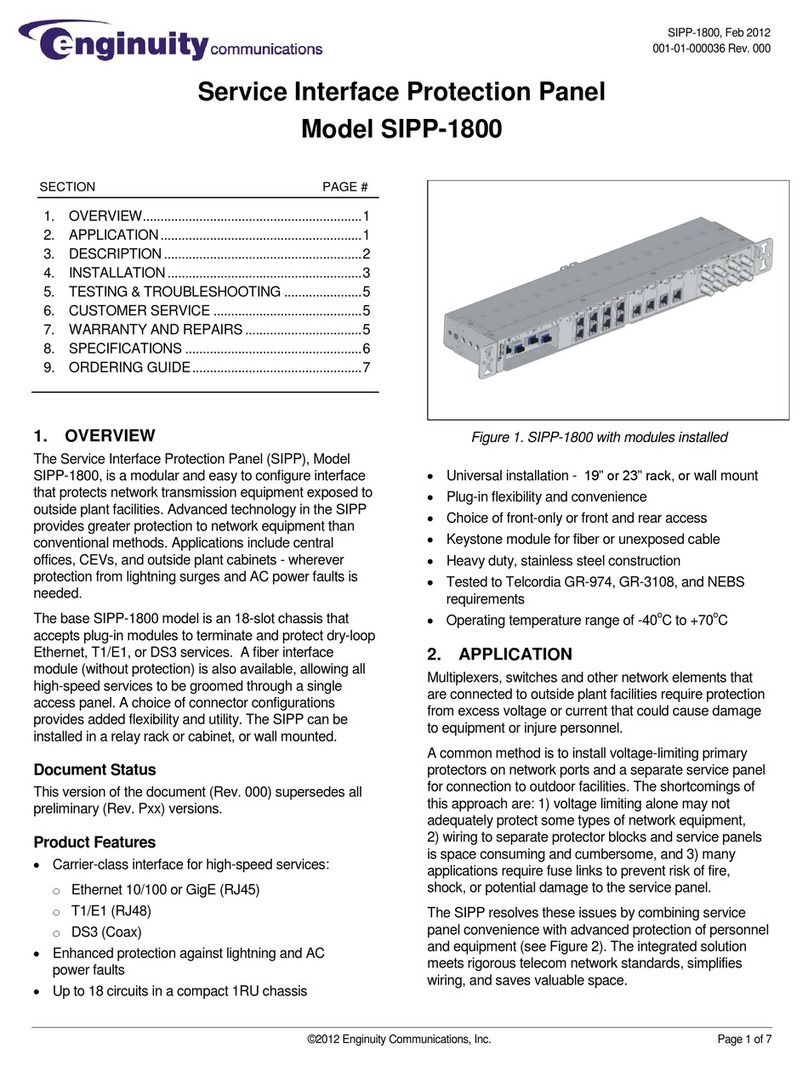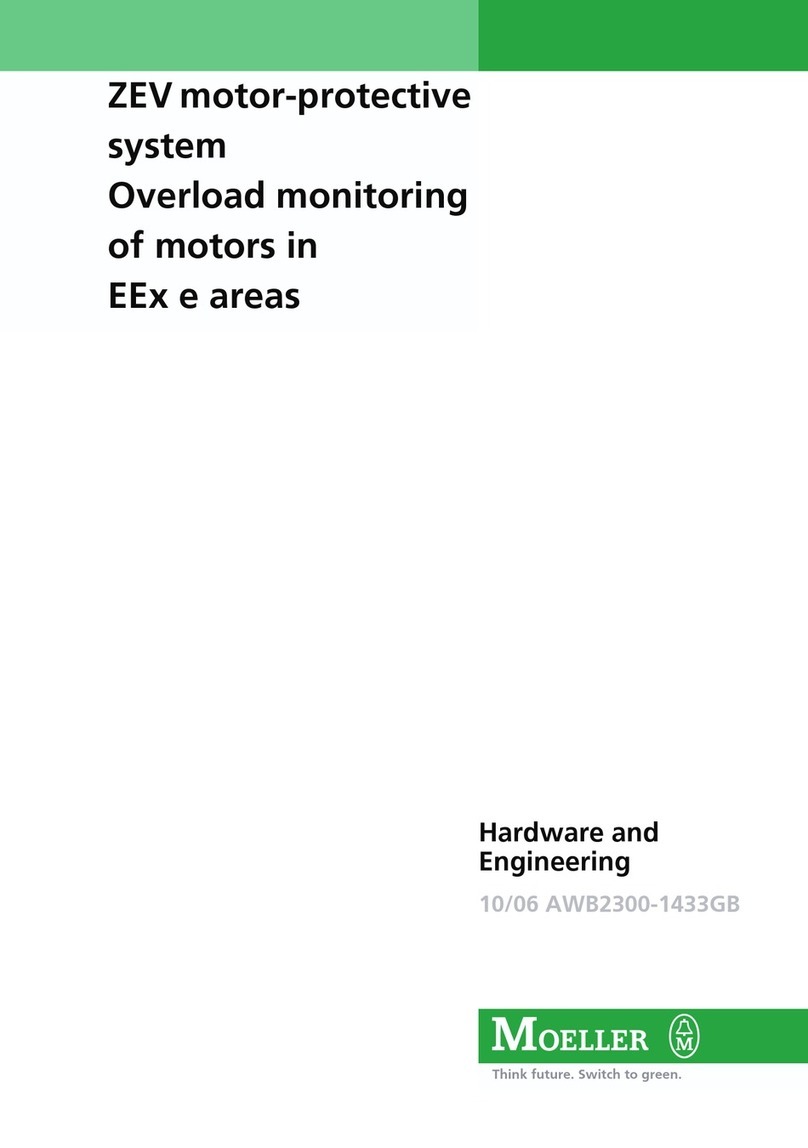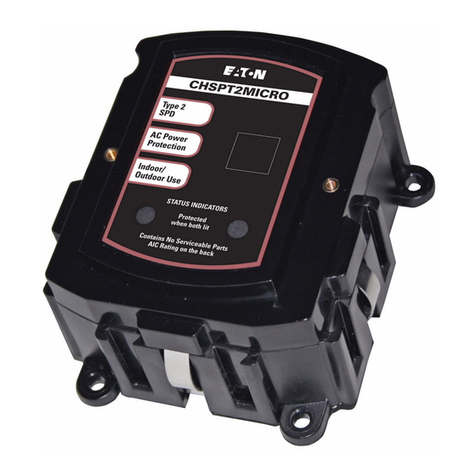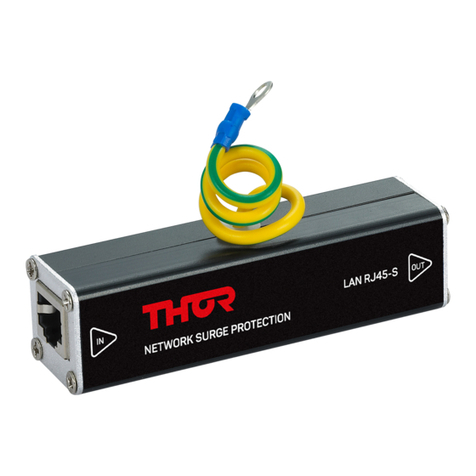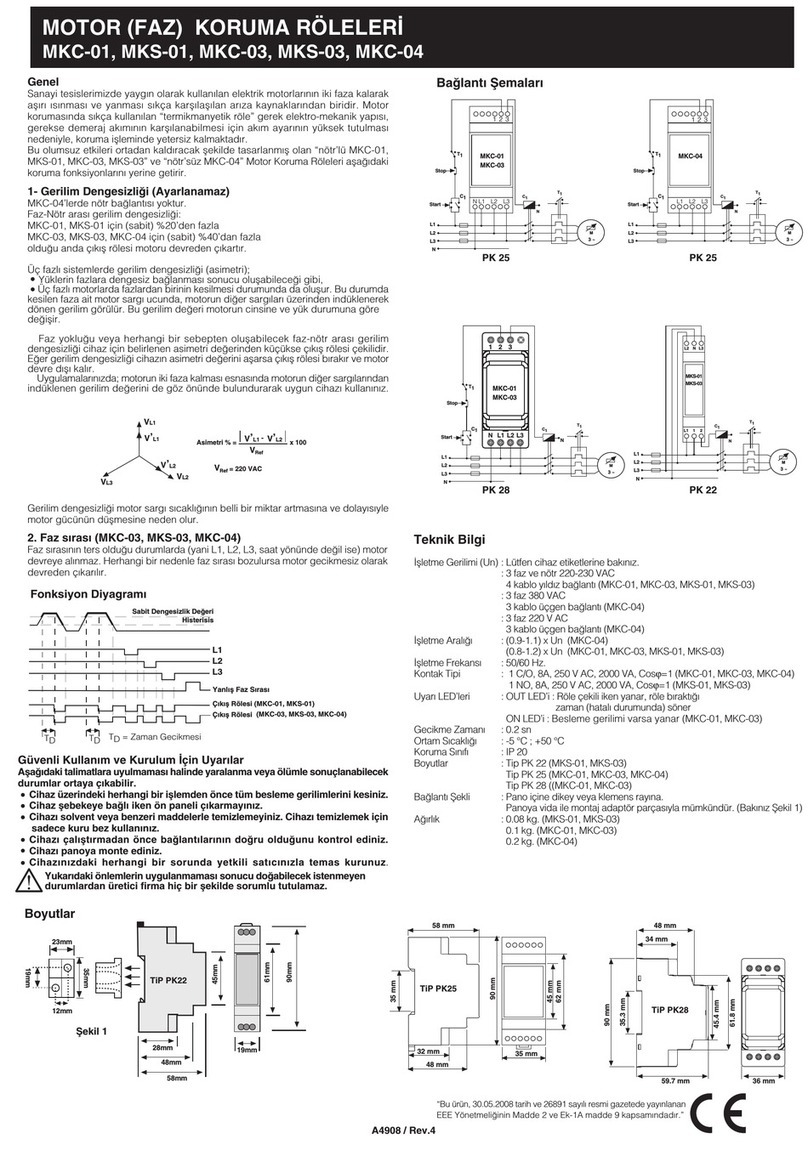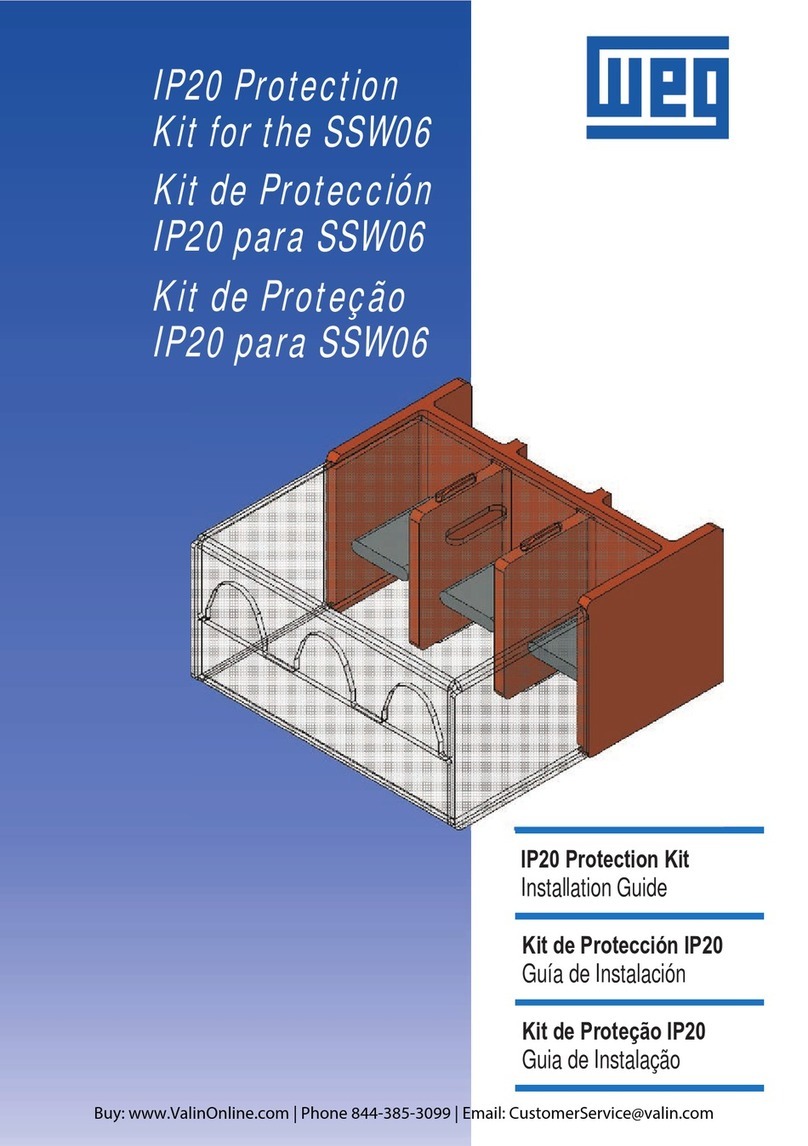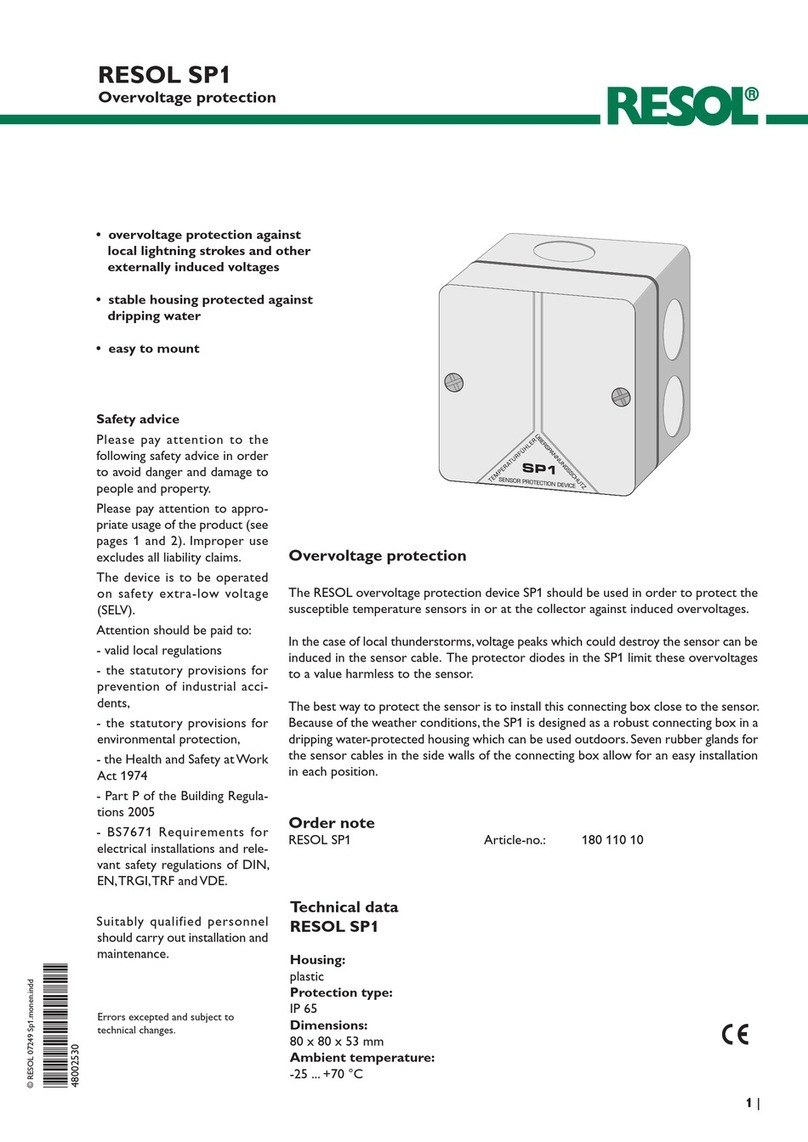Bodine BSL10LST User manual

SAVE THESE INSTRUCTIONS
THIS PRODUCT CONTAINS A RECHARGEABLE LITHIUM-ION BATTERY.
THE BATTERY MUST BE RECYCLED OR DISPOSED OF PROPERLY.
Bodine © 2018 Signify Holding. All rights reserved.
236 Mt. Pleasant Rd. • Collierville, TN USA 38017-2752 • Tech Support 888-263-4638 • Fax 901-853-5009 • www.bodine.com
442294606602
BSL10LST
02/07/19
Li - ion
CLASS 2 OUTPUT
Self-Testing Emergency LED Driver
READ AND FOLLOW ALL SAFETY INSTRUCTIONS
! IMPORTANT SAFEGUARDS ! WHEN USING ELECTRICAL EQUIPMENT, BASIC
SAFETY PRECAUTIONS SHOULD ALWAYS BE
FOLLOWED, INCLUDING THE FOLLOWING:
1. To prevent voltage from being present on output leads prior to installation, unit engage connector must be
open. Do not join unit engage connector until installation is complete and AC power is supplied to the
emergency driver.
2. This product is for use with an emergency LED lighting load and supplies nominaly 10.0 W of power, with
a voltage of 15-54 VDC in emergency mode for a minimum of 90 minutes, in compliance with NFPA-101 and
NEC 700.12.
3. Make sure all connections are in accordance with the National Electrical Code or Canadian Electrical Code and
any local regulations.
4. To reduce the risk of electric shock, disconnect both normal and emergency power supplies and unit engage
connector of the emergency driver before servicing.
5. This emergency driver is intended to be mounted and enclosed within a luminaire and is suitable for both
factory or field installation. For field installation, please see the instructions on page 2.
6. This product is suitable for use in damp locations where the ambient temperature is 0ºC minimum, +55ºC
maximum. Product is also suitable for installation in sealed and gasketed fixtures. Product is not suitable
for heated air outlets and wet or hazardous locations. Maximum allowable case temp is 63ºC. See Page 4
for Tcase measurement location.
7. An unswitched AC power source is required (120-277 VAC, 50/60 Hz).
8. Do not install near gas or electric heaters.
9. Do not attempt to service the battery. A sealed, no-maintenance battery is used that is not field replaceable.
Contact the manufacturer for information on service.
10. The use of accessory equipment not recommended by the manufacturer may cause an unsafe condition.
11. Do not use this product for other than intended use.
12. Servicing should be performed by qualified service personnel.
13. Equipment should be mounted in locations and at heights where it will not be subjected to tampering by
unauthorized personnel.
14. For Canadian application the output terminals should be in compliance with the accessibility requirement of
the Canadian Electric Code.
15. This device complies with part 15 of the FCC Rules. Operation is subject to the following two conditions: (1)
this device may not cause harmful interference, and (2) this device must accept any interference that may
cause undesired operation.
16. This product must be grounded. See the wiring diagrams for details.
Installation Instructions

INSTALLATION
22
NOTE: Make sure the necessary branch circuit wiring is available. An unswitched source of power is
required. The emergency driver must be fed from the same branch circuit as the AC driver.
CAUTION: DO NOT JOIN UNIT ENGAGE CONNECTOR UNTIL INSTALLATION IS COMPLETE AND AC POWER IS
SUPPLIED TO THE EMERGENCY DRIVER.
STEP #1 INSTALLING THE EMERGENCY DRIVER
> Disconnect AC power from the LED luminaire.
> Mount the emergency LED driver by the mounting tabs using the supplied screws. The luminaire’s installation
instructions may provide guidance on the recommended mounting location.
> Mounting Height: Many factors influence emergency illumination levels, such as the lamp load selected, luminare
design, and environmental factors therefore end use verification is necessary. For field installations, when the attached
luminaire is mounted at heights greater than 7.17ft (2.2m), the level of illumination must be measured in the end
application to ensure the requirements of NFPA 101 and local codes are satisfied.
> Remote Mounting: The emergency LED driver may be remote mounted from the luminaire it enclosed and installed in
accordanance with the NEC. If used in conjunction with an AC driver the allowed distance is up to half the distance the
AC driver manufacturer recommends remote mounting the AC driver from the LED load. If used without an AC driver, and
remote mounting more than 5 feet from the luminaire, please consult the factory to determine the necessary wire gauge.
CAUTION: Remote mounting can result in reduced power output.
Lumens In Emergency Mode = Lumens per Watt of Fixture * Output Power of Chosen Product
________________(Lumens)_ = __________________(lm/W)_* ________6______(W)_
1. Ensure the LED load’s rated power is greater than or equal to the power output of this emergency LED driver. This is to
ensure that this emergency product will not produce more power than the LED load can handle, thus ensuring that the
LED load will not be damaged when the system is in the emergency mode.
2. Verify that the forward voltage of the luminaire’s LED array is within the limits of this emergency LED driver. The forward
voltage of the LED array is commonly designated as Vf and should be found on the luminaire markings, in the luminaire
specifications, or imprinted directly on the LED arrays. If multiple LED arrays are to be driven, verify that the total
forward voltage is within the limits of this product. Using a voltage meter, it may be possible to directly measure the
voltage across the LED arrays when operating from the AC driver.
3. Ensure the output current of the AC LED driver does not exceed 5.0 Amps. This is the current into the blue wire connector.
4. Ensure there will be sufficient light output in the end application. Estimate the egress lighting illumination levels by
doing the following:
a. Find the efficacy of the LED load. This can be given by the luminaire manufacture. This number will be given in
lumens per watt (lm/w). It is the installer’s responsibility to validate the luminaire manufacturer’s efficacy data.
This can be accomplished by direct measurement, by review of independent 3rd party test data (UL, ETL, etc.),
accessing a public database of 3rd party data (such as Design Lights Consortium, www.designlights.org), or other
comparable means.
b. Lumens can be calculated by multiplying the output power of the emergency LED driver by the efficacy of the LED
load. In many cases the actual lumen output in emergency mode will be greater than this calculation gives, however
it will provide a good estimate for beginning the lighting design of the system.
C. Using the results of this calculation and industry standard lighting design tools, calculate the anticipated
illumination levels in the path of egress.
This product is suitable for field installation with suitable LED loads including LED luminaires, DC voltage driven LED
replacements for fluorescent lamps and others. There are four (4) checks to determine if your luminaire is eligible for field
installation.
NOTE: This product has been designed to reliably interface with a wide selection of LED loads and is electrically compatible
with every simple LED array that meets criteria 1 and 2 above. However, compatibility cannot be guaranteed with all current
and future LED systems. Compatibility testing of the end-use system is suggested. Please contact the factory with any
questions.
Installation of this emergency LED driver will vary based on the luminaire type, however, generally
follow these steps:
NOTE: After installation, it will be necessary to measure the egress lighting illumination levels to ensure it complies with
national, state, and local code requirements.

Connecting the unit engage connector enables the emergency circuit and supplies power to the control/monitor circuit and
charging indicator light. The self-testing emergency driver continually monitors the unit health. Should the unit detect an
unusual condition, the indicator light will flash.
When AC power fails, the self-testing emergency driver automatically switches to emergency mode, keeping the LED load
illuminated at a reduced lumen output for a minimum of 90 minutes. When AC power is restored, the
self-testing emergency driver returns to charging mode.
OPERATION
SELF-TESTING OPERATION
3
STEP #3 WIRING THE EMERGENCY DRIVER
> Select the appropriate wiring diagram to connect the emergency driver to the AC driver and LED load.
Make sure all connections are in accordance with the National Electrical Code and any local regulations.
> After installation is complete, supply AC power to the emergency driver and join the unit engage connector.
> At this point, power should be connected to both the AC driver and the emergency driver, and the Charging
Indicator Light should illuminate indicating the battery is charging.
> A short-term discharge test may be conducted after the emergency driver has been charged for one hour. Charge
for 24 hours before conducting a long-term discharge test. Refer to OPERATION.
> In a readily visible location, attach the label "CAUTION - This Unit Has More Than One Power Connection Point.
To Reduce The Risk Of Electric Shock, Disconnect Both The Branch Circuit-Breakers Or Fuses And Emergency
Power Supplies Before Servicing."
STEP #2 INSTALLING THE 2W-ITS ON FIXTURE SURFACE
> Mount the supplied 2W-ITS (2-wire illuminated test switch) in a location that is
visible and accessible by maintenance personnel. The 2W-ITS mounts through a
½” hole which may need to be made in the luminaire or could come pre-punched
by the luminaire supplier.
> Wire the test switch per wiring diagrams provided on these instructions.
> If wired correctly, the 2W-ITS indicator light should be ON when AC power is
supplied to the fixture, and the convertor connector is closed indicating that the
emergency inverter battery is charging. After installing, mark with the "PUSH TO
TEST" and "CHARGING INDICATOR LIGHT" labels.
Hex Nut
2 Wire
Illuminated
Test Switch
Fixture or
Test/Monitor Plate
Drill or Punch
a 1/2” Hole
Violet
Brown
This unit contains a control/monitor circuit that automatically performs a 30-second discharge test once a month and a
full 90-minute discharge test once a year. During routine testing, the self-testing emergency driver simulates an AC power
failure causing the unit to automatically switch to emergency mode. The unit will monitor the operation of the LED load,
battery voltage, LED load connections and emergency duration. If the emergency system functions properly, then the unit
will return to normal mode. Should the unit detect any problems, the indicator light will flash per failure condition (see
Troubleshooting guide) until the condition has been corrected and the unit passes the next test.
To reset a failure indication, turn off AC power to the emergency driver for a minimum of 10 seconds or briefly push the
2W-ITS. If the condition has not been corrected by the next scheduled test, the unit will once again detect the failure
and signal the failure indicator.
To perform a manual self-diagnostic test, push and hold 2W-ITS for minimum of 5 seconds. Once 2W-ITS is released the
emergency driver will perform a 30 second diagnostic test. During this test, unit will monitor the operation of the LED load,
battery voltage, and LED load connections. If the emergency system functions properly, the unit will return to normal mode.
Should the unit detect any problems, the indicator light will flash per failure condition (see Troubleshooting guide) until
the condition has been corrected and the unit passes the next test.

Failure Status will be reset when the unit passes:
• The next automatic test, or
• Briefly pressing the 2W-ITS, or
• A power failure exceeding 10 seconds.
NOTE: The unit engage connector pins must be connected for the emergency driver and AC driver to
operate normally.
4
EMERGENCY DRIVER AND AC DRIVER MUST BE FED FROM THE SAME BRANCH CIRCUIT
TYPICAL SCHEMATICS ONLY. MAY BE USED WITH OTHER DRIVERS. CONSULT THE FACTORY FOR OTHER WIRING DIAGRAMS.
WIRING DIAGRAMS
NOTE 1: For short-term testing of the emergency function, the battery must be charged for at least one hour.
The emergency driver must be charged for at least 24 hours before conducting a long-term test.
NOTE 2: Connections with * are Class 2 rated outputs.
Connections with # are Class 2 rated inputs only.
TCASE TEST POINT LOCATION
WITH THERMAL PROTECTOR
AC LED
DRIVER
LED +
LED -
GROUND
NEUTRAL
LINE
WALL
SWITCH
UNSWITCHED HOT
WHITE
(-)
(+)
BLACK
GRAY
BLUE #
BLACK
RED
BLACK #
GREEN
NEUTRAL
GROUND
WHITE
GRAY
GRAY
*
*
*
LED
LOAD
L
E
D
D
R
I
V
E
R
E
M
E
R
G
E
N
C
Y
UNIT
ENGAGE
GRAY
VIOLET VIOLET
BROWN BROWN
2W-ITS
*
*
*
BLUE
WHITE
BLACK
THERMAL
PROTECTOR
AC LED
DRIVER
WALL
SWITCH
UNSWITCHED HOT
WHITE
(-)
LED +
(+)
BLACK
GRAY
BLUE #
BLACK
RED
BLACK #
LED -
GREEN
NEUTRAL
GROUND
WHITE
GRAY
GROUND
NEUTRAL
LINE
GRAY
*
*
*
LED
LOAD
L
E
D
D
R
I
V
E
R
E
M
E
R
G
E
N
C
Y
UNIT
ENGAGE
GRAY
VIOLET VIOLET
BROWN BROWN
2W-ITS
*
*
*
0.59" (15 mm)
Tc
212 mm(8.03
")
MAINTENANCE
This self testing emergency driver automatically performs required routine testing. Results are reported to
maintenance personnel via the indicator light.
Note: Maintenance personnel should periodically check the indicator light. If the indicator light is flashing, follow steps
in the Troubleshooting Guide.
TROUBLESHOOTING GUIDE
STATUS INDICATOR
LIGHT
PROBLEM CORRECTIVE ACTION
Light on not flashing None None, Unit is Operating Correctly.
Flashing 2 times every 5 seconds Battery Error Charge battery. If after an hour failure is
still indicated, see action below.
Flashing 3 times every 5 seconds Charging Error
Ensure input wiring is correct and verify voltage is
correct and stable.
Flashing 4 times every 5 seconds Output Error
1. Output might be either open or short circuited.
2. Ensure that fixture wiring is in accordance with
proper wiring diagram.
3. Ensure connections to the LED load.
Continuous Flashing Application out
of range
Ensure
LED load is operational and specified
for self-testing emergency driver
Table of contents
Popular Protection Device manuals by other brands
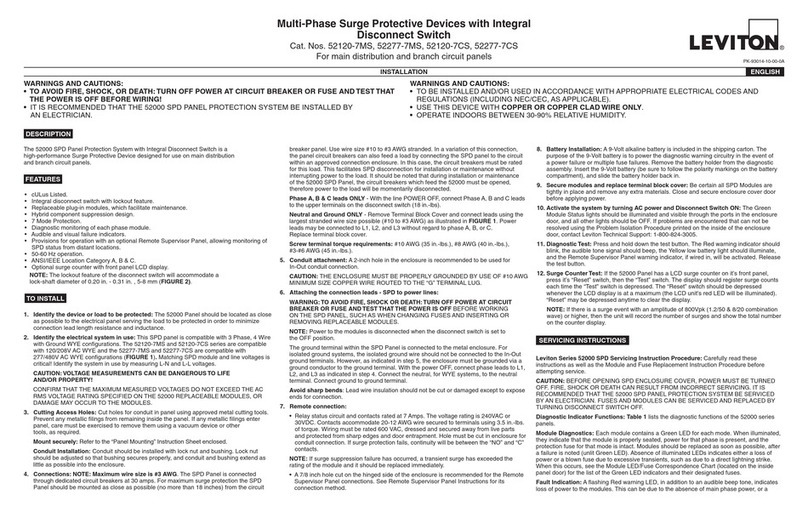
Leviton
Leviton 52120-7MS Installation

Kemper
Kemper 620 00 Installation and operating instructions

Franklin Electric
Franklin Electric submonitor owner's manual
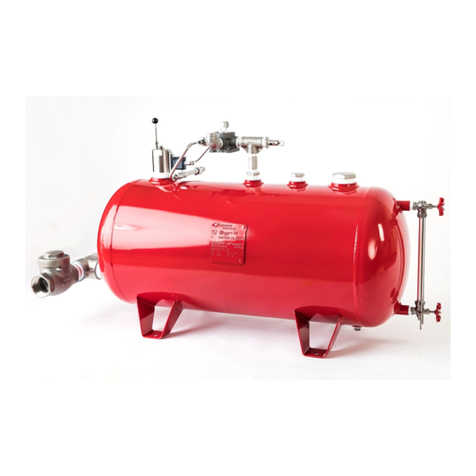
Jatco
Jatco J-7000 200 ABV installation instructions
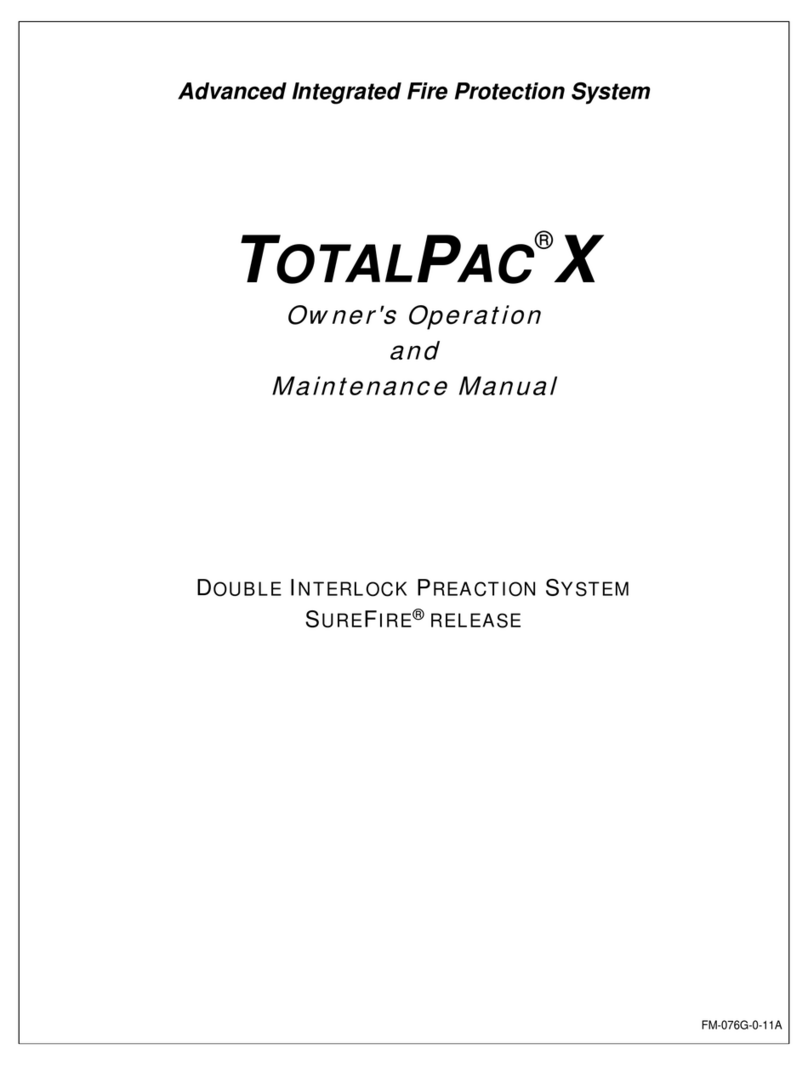
FireFlex
FireFlex TOTALPAC X Owner's operation and maintenance manual
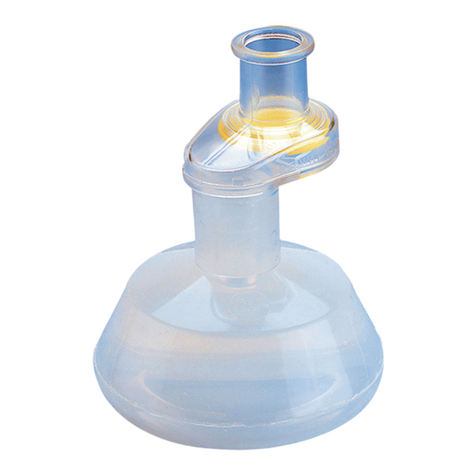
Fahl
Fahl LARYVOX TAPE Instructions for use
